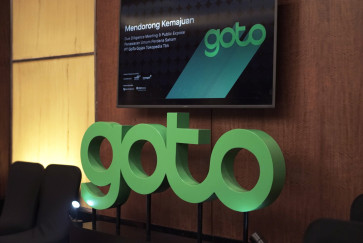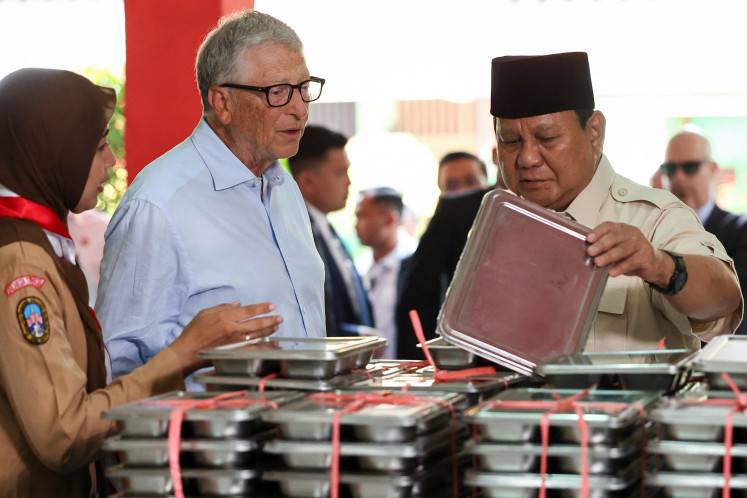Advantages of vintage
Catering to all: Pasar Kodok in Tabanan offers a diverse range of second-hand clothes for both adults and kids
Change text size
Gift Premium Articles
to Anyone

Catering to all: Pasar Kodok in Tabanan offers a diverse range of second-hand clothes for both adults and kids.
With the cost of living skyrocketing maintaining the life of a “fashionista” with individual flair calls for some lateral thinking. This is where second hand clothing, re-branded as “vintage” comes in; second hand clothes come at vintage prices, jeans cost a bit less than they did 20 years ago, unworn swimming costumes such as Mary Quant samples can be picked up at US$3.50 and kids clothes start at a dollar.
In Bali the center for second hand clothing and samples, some of which are edging the vintage realm when it comes to fashion, is Pasar Kodok in Tabanan’s outskirts.
Beginning life in a rice field back in 1998, today the market is a hive of cast off clothing kiosks, selling everything from lacey bustiers to sheep skin jackets.
A dealer in mens’ shirts, Madura born Franki Arifin has had his spot in the market since he was just 18 years old and retells the market history with pride.


“Pasar Kodok, the frog market, was first called Pasar OB, which means obralan besar — the big sale market, but was soon nick named Pasar Kodok because this was all rice fields and there were frogs everywhere. The first dealers here were a Madurese man named Mohamad Hassar and Mr. Joni. Then many other Madurese came to deal in second hand clothes and pretty soon it was a Kampung Madura [Maduran Village] that we call Kampung Kodok,” explains Franki.
The call of Bali and its market potential drew many Madurese from their home area of Sumenep, a dry and barren region says Franki, that offered little more than a life growing corn and praying for rain.

“I came here to find money and with the stall I can make enough to save a little bit and send money home to family. People like the clothing here because it is all imported, the quality is high. We have people from all walks of life, foreigners, artists from Jakarta — people who are from the high class to the low class — there is no class at the market,” says Franki.
Stocking market stalls can be a gamble says Pak Mia, a Balinese man who opened his stall eight years ago. His once tiny tarpaulin covered kiosk has grown almost as large as a small department store.
“We buy imported clothing in 100 kilogram [kg] lots. We don’t know what the lots contain — it could be 100 kg of swimming costumes, or 100 kg of jeans or dresses, but we don’t know the quality until we open the package. It could be great quality or the stock could all be water damaged from the sea journey here — that happens. The agents are fair, if the stock is ruined they return half the money we paid,” says Mia.
Prices for 100 kg of second hand imported clothing goes for between $300 and $600, depending on where the goods come from and the expected quality of the garments, says Mia who says he and his family have made a good living in the second hand garment trade.
Wandering the alleys of Pasar Kodok are teenage girls checking out cheeky denim cut offs, a couple of Italian women hunting down true vintage clothing from the 1950s — with little success — families looking for cheap kid’s wear and young men scrolling through rack after rack of jeans in search of the illusive button fly Levi 501s.
Long time kiosk holder Pak Ari has one pair of these classic jeans buried in a cupboard. Tagged as American made, the jeans would fetch a pretty penny, if not for their tiny size.
“These are originals. Real Levis made in America,” says Pak Ari who has lived on the Pasar Kodok site since he was a child.
“I’ve been here since I was small. My parents came down from Madura because my grandmother was making tempeh tahu here — it was still all rice fields then. About 1998 one little stall selling imported clothes opened up. Then one by one the market grew out of the rice fields,” says Pak Ari who believes being creative with his stock gives him an edge.
“We cut down jeans into shorts — we have new ideas all the time about how we can make the clothes fashionable. You have to be creative here; the shorts sell really well at $4 to $5 a pair. Long jeans are $6,” says Ari.

Pasar Kodok with its affordable imported clothing, is beneficial for all he says.
“From rich to poor, people can shop here and buy good quality clothes at low prices — all imported,” says Ari.
While there are mountains of wearable clothes on sale at Pasar Kodok, finding true vintage wear at this market might be a bit like finding a needle in a haystack. Hot and tired from her search for pre 1980’s clothes, Helena from Denmark was ready to give up.
“This is my first time here. I have heard a lot about this market — that it was a vintage clothing market. But it’s not from what I have seen so far. I have only visited a couple of kiosks, but today is so hot that I think I will come back when it’s cooler and maybe then I will have some luck,” Helena said, referring to the pre-loved clothing that travels from India, China, Japan, Korea, Australia and the US to become much loved bargains in Bali.

— Photos by JP/J.B.Djwan









